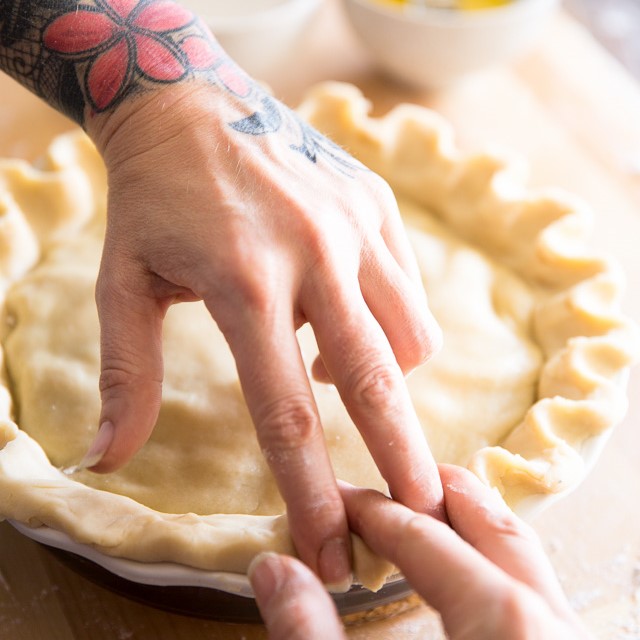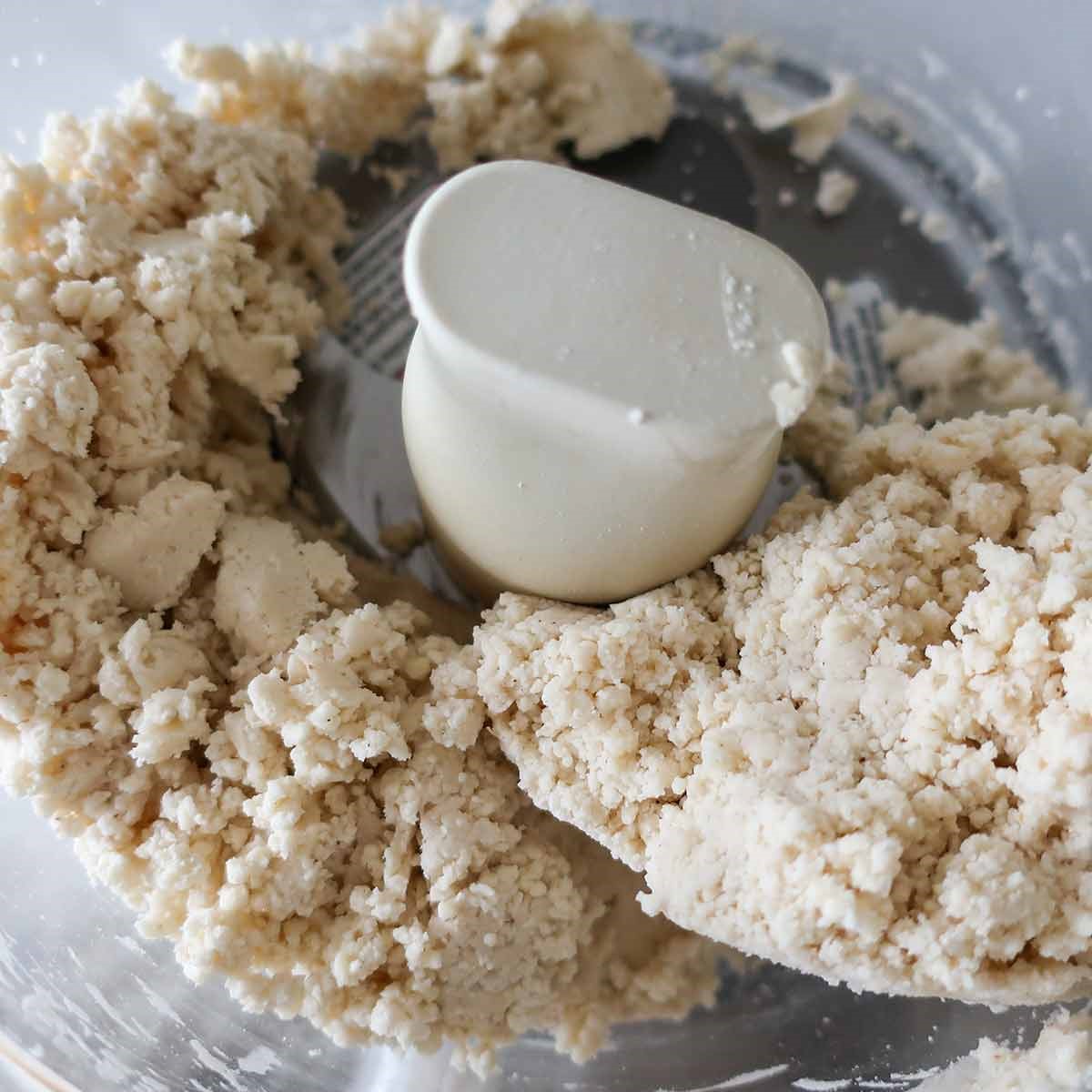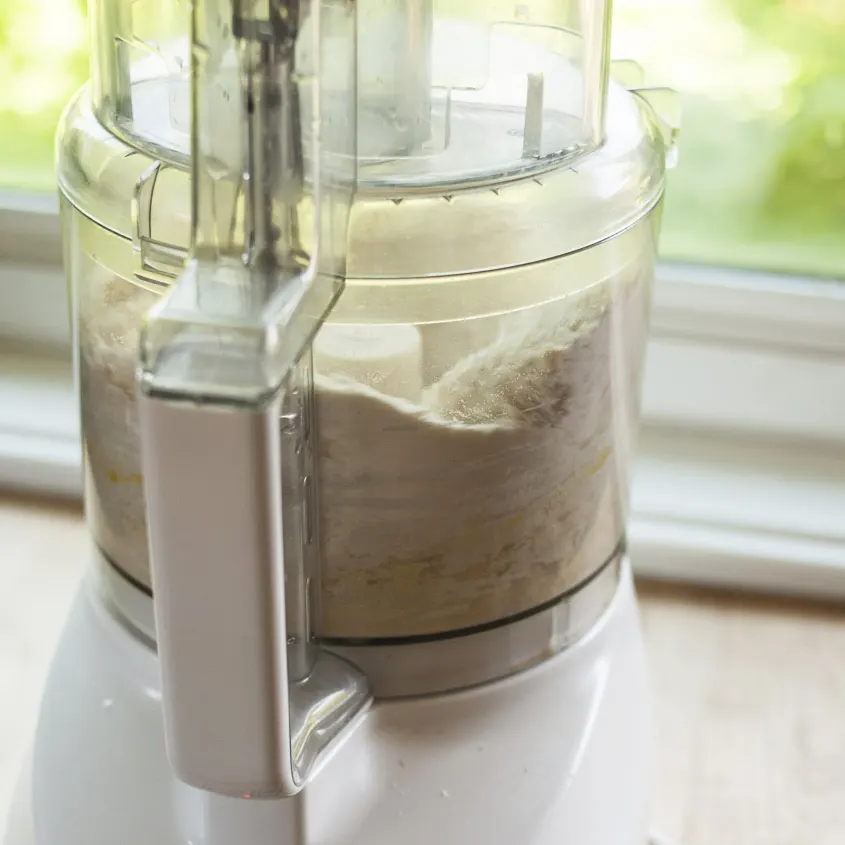
The Benefits of Using a Food Processor for Pie Dough
Using a food processor for pie dough has multiple benefits. First, it significantly cuts down the preparation time. Unlike traditional methods that require manual mixing and kneading, a food processor can combine your ingredients into a consistent dough in a fraction of the time. This speediness is ideal for busy bakers looking to efficiently manage their baking process.

Another major advantage is the consistency in texture it offers. Food processors blend the fat and flour uniformly, which is crucial for achieving flaky pie crusts. Manually blending these ingredients often results in uneven texture which can affect the crust’s delicacy.
Furthermore, food processors are excellent for keeping the ingredients cold during the dough-making process. The less handling with warm hands, the better, as heat can melt the fat and potentially affect the texture of the crust. Therefore, using a food processor minimizes this risk and contributes to a more tender and flaky crust.
Lastly, using a food processor for making pie dough reduces physical strain. Mixing dough by hand can be quite taxing especially for large batches or frequent baking. The food processor does all the heavy lifting, allowing you to save your energy for other baking tasks. This makes the food processor an invaluable tool for both novice and professional bakers.
Key Ingredients for Perfect Food Processor Pie Dough
To achieve the perfect pie dough with your food processor, you must start with the right ingredients. The foundation of any good pie dough is flour, fat, liquid, and salt.
Flour
All-purpose flour is the go-to choice for pie dough. It provides a balance between tenderness and structure. For a more delicate crust, some bakers opt for pastry flour. The key is to measure the flour accurately to ensure your dough’s consistency.
Fat
The type of fat you use affects the flavor and texture of the pie crust. Butter offers a rich taste and creates a flaky texture, while shortening offers a tender crust. For optimal processing, ensure the fat is cold and cut into small pieces before blending.
Liquid
Ice water is the most common liquid used in pie dough. It helps to bind the ingredients without promoting gluten development, which can make the crust tough. Use only as much liquid as needed; too much can lead to a sticky dough.
Salt
Salt enhances the flavor of the crust and also strengthens the dough structure. It is a small but essential component of pie dough.
Combine these key ingredients correctly, and your food processor will do the rest, delivering a perfect pie dough ready for baking.
Step-by-Step Guide to Making Pie Dough in a Food Processor
Creating pie dough with a food processor is simple and efficient. Follow this step-by-step guide to ensure perfect results every time.
Step 1: Measure Your Ingredients
Begin by accurately measuring your flour, fat, salt, and ice water. Precision is key to achieving the right dough consistency.
Step 2: Add Dry Ingredients to Food Processor
Place the flour and salt into the food processor. Pulse a few times to mix them well.
Step 3: Add the Fat
Distribute cold fat, either butter or shortening, into the food processor. Pulse until mixture looks like coarse crumbs.
Step 4: Add Ice Water
While pulsing, slowly add ice water. Stop as soon as the dough begins to clump.
Step 5: Check Dough Consistency
Pinch a small amount of dough. If it holds together, it’s ready. If not, add a bit more ice water.
Step 6: Turn Out the Dough
Empty the crumbly dough onto a clean surface. Press together to form a ball.
Step 7: Wrap and Chill
Flatten the dough into a disk. Wrap in plastic and chill in the fridge for at least one hour.
Step 8: Roll Out the Dough
After chilling, roll out the dough on a floured surface to your desired thickness.
Following these steps, you can quickly make food processor pie dough that’s flaky and tender. Keep the work area cool and limit handling to maintain the fat’s structure. Remember to clean your food processor right after to keep it in good condition.
Tips for Achieving Flaky and Tender Pie Crusts
Achieving a flaky and tender pie crust with your food processor involves a few key tips:
- Keep Ingredients Cold: Always use cold fat and ice water. This prevents the fat from melting too soon, which is crucial for flakiness.
- Avoid Over-Mixing: Over-mixing can lead to gluten development, making the crust tough. Pulse just until components combine into a crumbly mixture.
- Use Butter and Shortening: For a balance of flakiness and tenderness, consider using a combination of both butter and shortening.
- Pulse, Don’t Run: Use the pulse function instead of running the food processor continuously to better control the dough’s texture.
- Chill Dough Before Rolling: Chill the dough disk for at least an hour before rolling it out. This solidifies the fat and makes the dough easier to handle.
- Don’t Overwork the Dough: When forming your dough into a disk, handle it as little as possible. Overworking the dough warms the fat and affects the texture.
- Use Plastic Wrap: Pressing the dough together in plastic wrap helps it come together without additional water, which can make the crust chewy.
Incorporate these tips and the keyword ‘food processor pie dough’ into your baking routine for that ideal crust that complements any pie filling.
 Common Mistakes to Avoid When Making Pie Dough with a Food Processor
Common Mistakes to Avoid When Making Pie Dough with a Food Processor
Making pie dough with a food processor can be quick and efficient. However, bakers may encounter common pitfalls if not careful. Here are some mistakes to steer clear of when using a food processor to make pie dough:
- Overloading the Food Processor: Adding too much flour and fat at once can strain the motor. Add ingredients in batches if needed.
- Overprocessing the Dough: Once the dough starts to clump, stop. Overprocessing can cause heat buildup and result in tough dough.
- Not Starting with Cold Ingredients: Using ingredients that are not cold can result in a less flaky crust. Always use cold fat and ice-cold water.
- Ignoring Dough Texture: The dough should be crumbly, not smooth. If it’s too wet, add a bit more flour; if too dry, a splash more ice water.
- Skipping the Chill Step: Chilling the dough is crucial. It allows the fat to firm up again for a flaky crust.
- Rolling the Dough Too Soon: Rolling dough that hasn’t chilled properly can cause it to break or become too warm. Patience is key.
- Forgetting to Clean Regularly: Bits of dough can hide in nooks of the food processor. Clean after each use to prevent a sticky buildup.
Remembering these tips when making food processor pie dough will help you avoid common errors. By following best practices, you’ll achieve that flaky, tender crust that pie lovers adore.
How to Adapt Traditional Pie Dough Recipes for a Food Processor
Adapting traditional pie dough recipes for a food processor is straightforward. Begin by reviewing your favorite pie dough recipe. Identify the steps where mixing is required and adapt these for your food processor.
- Preparation: Firstly, gather all recipe ingredients. Measure them as specified to ensure accuracy.
- Blending Dry Ingredients: Add the flour and any dry seasonings like salt or sugar into the food processor. Use the pulse function to mix these ingredients evenly before adding fats.
- Incorporating Fat: Add cold chunks of butter or other fat types. Pulse the mixture until it resembles coarse crumbs. This step is crucial for texture.
- Adding Liquid: Gradually add ice water. Pulse the mixture just until it starts to form larger clumps. Avoid letting it turn into a continuous dough in the processor to prevent overworking.
- Final Touches: Once the dough reaches the desired consistency, turn it out onto a surface. Press it together gently to form a ball. Proceed with any additional recipe steps such as resting or chilling.
Adapting your traditional recipes to use a food processor saves time and can improve the consistency of your pie dough. Make sure to avoid over-pulsing to keep the dough flaky and tender.
Cleaning and Maintenance Tips for Your Food Processor After Making Dough
After crafting your food processor pie dough, cleaning and maintaining your appliance is vital. Here are some helpful tips:
- Unplug the Food Processor: Safety first. Always unplug the machine before cleaning.
- Disassemble Removable Parts: Take apart blades, bowls, and lids. These parts often require separate cleaning.
- Rinse with Warm Water: Start by rinsing off loose bits of dough with warm water.
- Use Mild Detergent: Apply a mild detergent to a sponge or brush to clean parts.
- Scrub Gently: Clean the nooks and crevices with care to remove dough pieces.
- Dry Thoroughly: After washing, dry all parts well before reassembling to prevent mold.
- Check Seals and Gaskets: Look for wear and tear. Replace them if necessary.
- Reassemble Properly: Make sure all components fit snugly back into place.
- Store Correctly: Keep your food processor in a dry, cool spot to avoid damage.
- Regular Checks: Periodically check for dull blades or motor issues. Service as needed.
By following these maintenance steps, you ensure your food processor is always ready for making perfect pie dough.
 Must-Try Pie Recipes to Make with Your Food Processor Dough
Must-Try Pie Recipes to Make with Your Food Processor Dough
Once you’ve mastered the art of making food processor pie dough, it’s time to put it to good use with some delicious pie recipes. These recipes not only enhance your baking skills but also allow you to savor the fruits of your labor. Below are must-try pie recipes that perfectly complement the texture and taste of your food processor pie dough.
- Classic Apple Pie: Nothing beats a classic. Gather fresh apples, cinnamon, and nutmeg for filling. The flaky crust made with your food processor will encase the sweet and spiced apples beautifully.
- Lemon Meringue Pie: This pie offers a zesty lemon filling topped with a soft, cloud-like meringue. The crust stays crisp and holds up well against the moist filling due to its flaky layers.
- Chocolate Silk Pie: Indulge in a rich chocolate filling nestled in a tender crust. This dessert is both luxurious and satisfying, a real treat for chocolate lovers.
- Pecan Pie: Filled with pecans and a gooey mixture of eggs, butter, and sugar, this pie is a traditional favorite. The robustness of your homemade dough complements the richness of the filling.
- Blueberry Pie: Make the most of berry season with a vibrant blueberry pie. The natural sweetness and slight tartness of the blueberries pair well with the buttery crust.
By experimenting with these recipes, you can enjoy a variety of flavors and textures that make the most out of your food processor pie dough. Each pie promises a delightful eating experience, from baking preparations to the final delicious slice.





